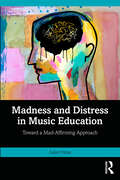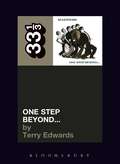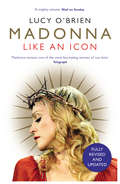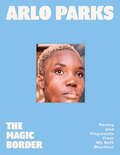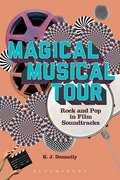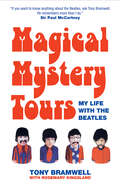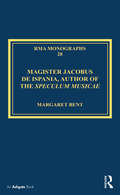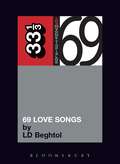- Table View
- List View
Madness and Distress in Music Education: Toward a Mad-Affirming Approach
by Juliet HessMadness and Distress in Music Education offers an in-depth exploration of mental health and emotional distress in the context of music education, offering new ways of thinking about these experiences and constructing ways to support distress through affirming pedagogy, practices, and policies in music education. Centering the lived experiences of 15 people in a range of roles across music education who self-identify an issue with their mental health, the volume addresses impacts on both students and educators. The author draws on Mad Studies and disability studies to present new paradigms for thinking about Madness and distress in the music context. An essential resource for music educators, music education researchers, and preservice students seeking to understand the complexities of mental health in the music classroom, this book considers how people conceptualize their mental health, how distress impacts participation in music education, how music education may support or exacerbate distress, and what supports for distress can be implemented in music education.
Madness and Distress in Music Education: Toward a Mad-Affirming Approach
by Juliet HessMadness and Distress in Music Education offers an in-depth exploration of mental health and emotional distress in the context of music education, offering new ways of thinking about these experiences and constructing ways to support distress through affirming pedagogy, practices, and policies in music education. Centering the lived experiences of 15 people in a range of roles across music education who self-identify an issue with their mental health, the volume addresses impacts on both students and educators. The author draws on Mad Studies and disability studies to present new paradigms for thinking about Madness and distress in the music context. An essential resource for music educators, music education researchers, and preservice students seeking to understand the complexities of mental health in the music classroom, this book considers how people conceptualize their mental health, how distress impacts participation in music education, how music education may support or exacerbate distress, and what supports for distress can be implemented in music education.
Madness' One Step Beyond... (33 1/3)
by Terry EdwardsOne Step Beyond isn't the best album in the world - it's not even the best album by Madness. It is, however, a great record and an exceptional debut album -fully formed despite half the band still being in their teens - and it remains as exhilarating, inspiring and as much fun as when people first heard it nearly 30 years ago. Through extensive interviews with the band, as well as producers Clive Langer & Alan Winstanley, Terry Edwards tells the inside story of how Madness rose to be the most successful singles band of the 1980s in the UK charts.
Madness' One Step Beyond... (33 1/3)
by Terry EdwardsOne Step Beyond isn't the best album in the world - it's not even the best album by Madness. It is, however, a great record and an exceptional debut album -fully formed despite half the band still being in their teens - and it remains as exhilarating, inspiring and as much fun as when people first heard it nearly 30 years ago. Through extensive interviews with the band, as well as producers Clive Langer & Alan Winstanley, Terry Edwards tells the inside story of how Madness rose to be the most successful singles band of the 1980s in the UK charts.
Madonna: A Rebel Life - The Biography
by Mary Gabriel'A whopping biography of the pop phenomenon and queen of reinvention. Life is a mystery - hers oughtn't to be after reading this.' THE TIMES, ' biggest books for autumn''A fascinating take on one of music's greatest icons' BELFAST TELEGRAPHIn this exceptional biography, Pulitzer Prize finalist Mary Gabriel chronicles the meteoric rise and enduring influence of the greatest female pop icon of the modern era: Madonna.'Daring to write a biography of a woman with whom the entire world is on a first-name basis, Mary Gabriel has created (astonishingly) a book neither gossip-driven nor highly snarky... she reveals instead a Madonna both more true and more unbelievably believable; a rock-and-roll suffragette... Norman Mailer once said to Madonna, 'I've come to the conclusion that you are a great artist.' Exquisitely detailed in her storytelling, Gabriel is clearly in that camp, convincing us that we all still vogue in the House of Madonna.'Brad Gooch, author of City Poet With her arrival on the music scene in the early 1980s, Madonna generated nothing short of an explosion - as great as that of Elvis or the Beatles - taking the nation by storm with her liberated politics and breathtaking talent. But Madonna was more than just a pop star. Everywhere, fans gravitated to her as an emblem of a new age, one in which feminism could shed the buttoned-down demeanour of the 1970s and feel relevant to a new generation. Amid the scourge of AIDS, she brought queer identities into the mainstream, fiercely defending a person's right to love whomever - and be whoever - they wanted. Despite fierce criticism, she never separated her music from her political activism. And as an artist, she never stopped experimenting. Madonna existed to push past boundaries by creating provocative, visionary music, videos, films and live performances that changed culture globally. Deftly tracing Madonna's story from her Michigan roots to her rise to super-stardom, master biographer Mary Gabriel captures the dramatic life and achievements of one of the greatest artists of our time.
Madonna (Mammoth Ser.)
by Michelle MorganMadonna: singer, songwriter, actress, businesswoman, not to mention one of the most renowned cultural icons of the last three decades. Since her first, eponymous album, over thirty years ago Madonna has sold a remarkable 300 million records worldwide, making her the top-selling female recording artist of all time.Madonna is famous for continuously reinventing both her music and her image. By pushing the boundaries of mainstream popular music with both her lyrical content and the imagery in her music videos she achieved extraordinary popularity. Morgan offers a richly illustrated, comprehensive account of the artist's phenomenally successful career shedding new light on her videos, books, tours, fashion, charity work and every other aspect of her life.Praise for Marilyn Monroe: Private and Undisclosed:'A gorgeous collection offering a fascinating insight into Monroe's personal life' Women & Home'A touching portrayal of the star in her more private moments' Empire'The most authoritative book on the star to date' Choice
Madonna: Like an Icon
by Lucy O'BrienThe definitive biography of one of the world’s most famous women.Madonna is the biggest-selling female recording artist in the world and one of our greatest living pop stars. With each pioneering album she has consistently reinvented her music and her image, transcending the world of pop to become a global cultural icon. In 2018, unbelievably, she is hitting her 60th birthday – yet she still remains as relevant as ever. Lucy O’Brien’s extensive and well-researched biography looks at Madonna the artist, offering a detailed analysis of her music with input from acclaimed musicians and producers, as well revealing interviews from her intimate inner circle. She follows Madonna from her difficult childhood and those frenetic early years in New York, through the shocks and scandals of the 1990s Sex era to her twenty-first-century incarnation as an outspoken activist.Providing a fascinating insight into her life, relationships and what motivates her as a woman and an artist, Madonna: Like an Icon is the definitive biography of one of the biggest stars in the world.
Madonna: An Intimate Biography of an Icon at Sixty
by J. Randy TaraborrelliFor more than three decades, Madonna has been generating headlines and topping charts. Now J. Randy Taraborrelli has written the definitive biography of one of the richest and most successful pop stars in the world, whose music has constantly evolved and who has remained relevant even as she hits her sixtieth year.From the driven, ambitious young woman struggling to get a break in New York to the outrageous pop diva and more spiritual mother, the changing faces of Madonna are revealed. We see her relationships with men like Basquiat, Tupac, Prince and Warren Beatty, and what happened in her marriages to Sean Penn and Guy Ritchie. We see her embracing motherhood. And we see her today with five children, still recording and touring, finding happiness with much younger boyfriends, defiantly living life on her own terms. Madonna is based on decades of research and exclusive interviews with people speaking of her publicly for the first time – including friends, business associates and even family members. J. Randy Taraborrelli has also interviewed the star herself on numerous occasions and he draws on first-hand experiences to bring Madonna to life as not merely a sensational tabloid delight, but as a flesh-and-blood woman with human foibles and weaknesses, as well as great strengths and ambitions.
Madonna's Erotica (33 1/3)
by Michael DangoEveryone wanted Madonna's 1992 album Erotica to be a scandal. In the midst of a culture war, conservatives wanted it to be proof of the decline of family values. The target of conservative loathing, gay men reeling from the AIDS epidemic wanted it to be a celebration of a sexual culture that had rapidly slipped away. And Madonna herself wanted to sell scandal, which is why she released Erotica in the same season as her erotic thriller Body of Evidence and her pornographic coffee-table book simply titled Sex. But Erotica is more sentimental than pornographic. This ambivalence over sex is what makes the album crucial both for understanding its time and for navigating culture a generation later. As queer politics were transitioning from sexual liberation to civil rights like same-sex marriage, Madonna tried to do both. Her songs proved formative for works of queer theory, which emerged in the academy at the same time as the album. And Erotica was-and is-central to a developing consciousness about cultural appropriation. In this book, Michael Dango considers Erotica and its legacy by drawing both on the intellectual traditions at the center of today's hysteria over critical race theory and “don't say gay” and on his own experiences as a gay man too young to know the original carnage of AIDS and too old to grow up assuming he could get married. Madonna offered up Erotica as a key entry in the 1990s culture wars. Her album speaks all the more urgently to the culture wars of today
Madonna's Erotica (33 1/3)
by Michael DangoEveryone wanted Madonna's 1992 album Erotica to be a scandal. In the midst of a culture war, conservatives wanted it to be proof of the decline of family values. The target of conservative loathing, gay men reeling from the AIDS epidemic wanted it to be a celebration of a sexual culture that had rapidly slipped away. And Madonna herself wanted to sell scandal, which is why she released Erotica in the same season as her erotic thriller Body of Evidence and her pornographic coffee-table book simply titled Sex. But Erotica is more sentimental than pornographic. This ambivalence over sex is what makes the album crucial both for understanding its time and for navigating culture a generation later. As queer politics were transitioning from sexual liberation to civil rights like same-sex marriage, Madonna tried to do both. Her songs proved formative for works of queer theory, which emerged in the academy at the same time as the album. And Erotica was-and is-central to a developing consciousness about cultural appropriation. In this book, Michael Dango considers Erotica and its legacy by drawing both on the intellectual traditions at the center of today's hysteria over critical race theory and “don't say gay” and on his own experiences as a gay man too young to know the original carnage of AIDS and too old to grow up assuming he could get married. Madonna offered up Erotica as a key entry in the 1990s culture wars. Her album speaks all the more urgently to the culture wars of today
Madvillain's Madvillainy (33 1/3)
by Will HagleThis book celebrates Madvillainy as a representation of two genius musical minds melding to form one revered supervillain. A product of circumstance, the album came together soon after MF DOOM's resurgence and Madlib's reluctant return from avant-garde jazz to hip-hop. Written from the alternating perspectives of three fake music journalist superheroes-featuring interviews with Wildchild, M.E.D., Walasia, Daedelus, Stones Throw execs, and many other real individuals involved with the album's creation-this book blends fiction and non-fiction to celebrate Madvillainy not just as an album, but as a folkloric artifact. It is one specific retelling of a story which, like Madvillain's music, continues to spawn infinite legends.
Madvillain's Madvillainy (33 1/3)
by Will HagleThis book celebrates Madvillainy as a representation of two genius musical minds melding to form one revered supervillain. A product of circumstance, the album came together soon after MF DOOM's resurgence and Madlib's reluctant return from avant-garde jazz to hip-hop. Written from the alternating perspectives of three fake music journalist superheroes-featuring interviews with Wildchild, M.E.D., Walasia, Daedelus, Stones Throw execs, and many other real individuals involved with the album's creation-this book blends fiction and non-fiction to celebrate Madvillainy not just as an album, but as a folkloric artifact. It is one specific retelling of a story which, like Madvillain's music, continues to spawn infinite legends.
Maggie's Boy
by Beryl KingstonWhen Alison marries Rigby Toan she cannot believe her luck. Rigg is the perfect husband – loving, ambitious and attractive – and everybody envies them their happiness. But when the recession takes hold Rigg's facade is stripped away and his flashy car and sharp suits prove to be bought by expensive lies. As debts spiral out of control and their home is repossessed, Alison is forced to open her eyes to the world and to the sort of man her husband really is. From his position as a private investigator, Morgan watches as Alison trudges the weary path of poverty and despair. But even he underestimates the inspirational strengths of her determination to eventually win through. Maggie's Boy, first published in 1994, is a heartwarming story of the determination and love that can conquer a change of fortune and terrible hardship.
The Magic Border
by Arlo Parks‘An embrace of a book’ Florence Welch ‘Poetry was my place, my little clearing in the forest, where I could quietly put everything I was holding. I’m not sure what gave me the courage to open up that space to you, but here I am, doing it.’
Magic Flutes
by Eva IbbotsonSpring, 1922Tessa is a beautiful, tiny, dark-eyed princess - who's given up her duties to follow her heart, working for nothing backstage at the Viennese opera. No one there knows who she really is, or that a fairy-tale castle is missing its princess, and Tessa is determined to keep it that way.But secret lives can be complicated, and when a wealthy, handsome Englishman discovers this bewitching urchin backstage, Tessa's two lives collide - and in escaping her inheritance, she finds her destiny. . .Magic Flutes is an enchanting story of love, music and secret princesses from Eva Ibbotson.
Magic Flutes and Enchanted Forests: The Supernatural in Eighteenth-Century Musical Theater
by David J. BuchDrawing on hundreds of operas, singspiels, ballets, and plays with supernatural themes, Magic Flutes and Enchanted Forests argues that the tension between fantasy and Enlightenment-era rationality shaped some of the most important works of eighteenth-century musical theater and profoundly influenced how audiences and critics responded to them. David J. Buch reveals that despite—and perhaps even because of—their fundamental irrationality, fantastic and exotic themes acquired extraordinary force and popularity during the period, pervading theatrical works with music in the French, German, and Italian mainstream. Considering prominent compositions by Gluck, Rameau, and Haydn, as well as many seminal contributions by lesser-known artists, Buch locates the origins of these magical elements in such historical sources as ancient mythology, European fairy tales, the Arabian Nights, and the occult. He concludes with a brilliant excavation of the supernatural roots of Mozart’s The Magic Flute and Don Giovanni, building a new foundation for our understanding of the magical themes that proliferated in Mozart’s wake.
Magic Flutes and Enchanted Forests: The Supernatural in Eighteenth-Century Musical Theater
by David J. BuchDrawing on hundreds of operas, singspiels, ballets, and plays with supernatural themes, Magic Flutes and Enchanted Forests argues that the tension between fantasy and Enlightenment-era rationality shaped some of the most important works of eighteenth-century musical theater and profoundly influenced how audiences and critics responded to them. David J. Buch reveals that despite—and perhaps even because of—their fundamental irrationality, fantastic and exotic themes acquired extraordinary force and popularity during the period, pervading theatrical works with music in the French, German, and Italian mainstream. Considering prominent compositions by Gluck, Rameau, and Haydn, as well as many seminal contributions by lesser-known artists, Buch locates the origins of these magical elements in such historical sources as ancient mythology, European fairy tales, the Arabian Nights, and the occult. He concludes with a brilliant excavation of the supernatural roots of Mozart’s The Magic Flute and Don Giovanni, building a new foundation for our understanding of the magical themes that proliferated in Mozart’s wake.
Magic Flutes and Enchanted Forests: The Supernatural in Eighteenth-Century Musical Theater
by David J. BuchDrawing on hundreds of operas, singspiels, ballets, and plays with supernatural themes, Magic Flutes and Enchanted Forests argues that the tension between fantasy and Enlightenment-era rationality shaped some of the most important works of eighteenth-century musical theater and profoundly influenced how audiences and critics responded to them. David J. Buch reveals that despite—and perhaps even because of—their fundamental irrationality, fantastic and exotic themes acquired extraordinary force and popularity during the period, pervading theatrical works with music in the French, German, and Italian mainstream. Considering prominent compositions by Gluck, Rameau, and Haydn, as well as many seminal contributions by lesser-known artists, Buch locates the origins of these magical elements in such historical sources as ancient mythology, European fairy tales, the Arabian Nights, and the occult. He concludes with a brilliant excavation of the supernatural roots of Mozart’s The Magic Flute and Don Giovanni, building a new foundation for our understanding of the magical themes that proliferated in Mozart’s wake.
Magical Musical Tour: Rock and Pop in Film Soundtracks
by Kevin J. DonnellyWinner of the Southwest Popular and American Culture Association's 2016 Peter C. Rollins Book Award in the category of Film/TelevisionThe popular music industry has become completely interlinked with the film industry. The majority of mainstream films come with ready-attached songs that may or may not appear in the film but nevertheless will be used for publicity purposes and appear on a soundtrack album. In many cases, popular music in films has made for some of the most striking moments in films and the most dramatic aesthetic action in cinema, like Ben relaxing in the pool to Simon and Garfunkel's 'The Sound of Silence' in The Graduate (1967), and the potter's wheel sequence with the Righteous Brothers' 'Unchained Melody' in Ghost (1990). Yet, to date, there have only been patchy attempts to deal with popular music's relationship with film. Indeed, it is startling that there is so little written on subject that is so popular as a consumer item and thus has a significant cultural profile.Magical Musical Tour is the first sustained and focused survey to engage the intersection of the two on both an aesthetic and industrial level. The chapters are historically-inspired reviews, discussing many films and musicians, while others will be more concentrated and detailed case studies of single films. Including an accompanying website and a timeline giving a useful snapshot around which readers can orient the book, Kevin Donnelly explores the history of the intimate bond between film and music, from the upheaval that rock'n'roll caused in the mid-1950s to the more technical aspects regarding 'tracking' and 'scoring'.
Magical Musical Tour: Rock and Pop in Film Soundtracks
by Kevin J. DonnellyWinner of the Southwest Popular and American Culture Association's 2016 Peter C. Rollins Book Award in the category of Film/TelevisionThe popular music industry has become completely interlinked with the film industry. The majority of mainstream films come with ready-attached songs that may or may not appear in the film but nevertheless will be used for publicity purposes and appear on a soundtrack album. In many cases, popular music in films has made for some of the most striking moments in films and the most dramatic aesthetic action in cinema, like Ben relaxing in the pool to Simon and Garfunkel's 'The Sound of Silence' in The Graduate (1967), and the potter's wheel sequence with the Righteous Brothers' 'Unchained Melody' in Ghost (1990). Yet, to date, there have only been patchy attempts to deal with popular music's relationship with film. Indeed, it is startling that there is so little written on subject that is so popular as a consumer item and thus has a significant cultural profile.Magical Musical Tour is the first sustained and focused survey to engage the intersection of the two on both an aesthetic and industrial level. The chapters are historically-inspired reviews, discussing many films and musicians, while others will be more concentrated and detailed case studies of single films. Including an accompanying website and a timeline giving a useful snapshot around which readers can orient the book, Kevin Donnelly explores the history of the intimate bond between film and music, from the upheaval that rock'n'roll caused in the mid-1950s to the more technical aspects regarding 'tracking' and 'scoring'.
Magical Mystery Tours: My Life With The Beatles
by Tony BramwellTony Bramwell's remarkable life with The Beatles began in a post-war Liverpool suburb where he was childhood friends with John, Paul and George. By the time he unexpectedly ran into George Harrison on top of a bus, Tony was well into a life story absolutely unlike any other.
Magister Jacobus de Ispania, Author of the Speculum musicae (Royal Musical Association Monographs)
by Margaret BentThe Speculum musicae of the early fourteenth century, with nearly half a million words, is by a long way the largest medieval treatise on music, and probably the most learned. Only the final two books are about music as commonly understood: the other five invite further work by students of scholastic philosophy, theology and mathematics. For nearly a century, its author has been known as Jacques de Liège or Jacobus Leodiensis. ’Jacobus’ is certain, fixed by an acrostic declared within the text; Liège is hypothetical, based on evidence shown here to be less than secure. The one complete manuscript, Paris BnF lat. 7207, thought by its editor to be Florentine, can now be shown on the basis of its miniatures by Cristoforo Cortese to be from the Veneto, datable c. 1434-40. New documentary evidence in an Italian inventory, also from the Veneto, describes a lost copy of the treatise dating from before 1419, older than the surviving manuscript, and identifies its author as ’Magister Jacobus de Ispania’. If this had been known eighty years ago, the Liège hypothesis would never have taken root. It invites a new look at the geography and influences that played into this central document of medieval music theory. The two new attributes of ’Magister’ and ’de Ispania’ (i.e. a foreigner) prompted an extensive search in published indexes for possible identities. Surprisingly few candidates of this name emerged, and only one in the right date range. It is here suggested that the author of the Speculum is either someone who left no paper trail or James of Spain, a nephew of Eleanor of Castile, wife of King Edward I, whose career is documented mostly in England. He was an illegitimate son of Eleanor’s older half-brother, the Infante Enrique of Castile. Documentary evidence shows that he was a wealthy and well-travelled royal prince who was also an Oxford magister. The book traces his career and the likelihood of his authorship of the Speculum musicae.
Magister Jacobus de Ispania, Author of the Speculum musicae (Royal Musical Association Monographs)
by Margaret BentThe Speculum musicae of the early fourteenth century, with nearly half a million words, is by a long way the largest medieval treatise on music, and probably the most learned. Only the final two books are about music as commonly understood: the other five invite further work by students of scholastic philosophy, theology and mathematics. For nearly a century, its author has been known as Jacques de Liège or Jacobus Leodiensis. ’Jacobus’ is certain, fixed by an acrostic declared within the text; Liège is hypothetical, based on evidence shown here to be less than secure. The one complete manuscript, Paris BnF lat. 7207, thought by its editor to be Florentine, can now be shown on the basis of its miniatures by Cristoforo Cortese to be from the Veneto, datable c. 1434-40. New documentary evidence in an Italian inventory, also from the Veneto, describes a lost copy of the treatise dating from before 1419, older than the surviving manuscript, and identifies its author as ’Magister Jacobus de Ispania’. If this had been known eighty years ago, the Liège hypothesis would never have taken root. It invites a new look at the geography and influences that played into this central document of medieval music theory. The two new attributes of ’Magister’ and ’de Ispania’ (i.e. a foreigner) prompted an extensive search in published indexes for possible identities. Surprisingly few candidates of this name emerged, and only one in the right date range. It is here suggested that the author of the Speculum is either someone who left no paper trail or James of Spain, a nephew of Eleanor of Castile, wife of King Edward I, whose career is documented mostly in England. He was an illegitimate son of Eleanor’s older half-brother, the Infante Enrique of Castile. Documentary evidence shows that he was a wealthy and well-travelled royal prince who was also an Oxford magister. The book traces his career and the likelihood of his authorship of the Speculum musicae.
The Magnetic Fields' 69 Love Songs (33 1/3)
by Ld BeghtolA fully illustrated oral history of the Magnetic Fields' 1999 triple album, 69 Love Songs - an album that was afforded "classic" status by many almost as soon as it was released. LD Beghtol's book is chatty, incestuous, funny, dark, digressive, sexy, maddening, and delightful in equal measures. It documents a vital and influential scene from the inside, involving ukuleles and tears, citations and footnotes, analogue drum machines, and floods of cognac. Oh, and a crossword puzzle too. The centre of the book is the secret history of these tuneful, acerbic, and sometimes heartbreaking songs of old love, new love, lost love, punk rock love, gay love, straight love, experimental music love, true love, blue love, and the utter lack of love that fill the album - as told by participants, fans, imitators, naysayers, and others.  Also included are a lexicon of words culled from the album's lyrics, recording details, performance notes from the full album shows in New York, Boston and London, plus rare and unpublished images, personal memorabilia, and much much more.
The Magnetic Fields' 69 Love Songs (33 1/3)
by Ld BeghtolA fully illustrated oral history of the Magnetic Fields' 1999 triple album, 69 Love Songs - an album that was afforded "classic" status by many almost as soon as it was released. LD Beghtol's book is chatty, incestuous, funny, dark, digressive, sexy, maddening, and delightful in equal measures. It documents a vital and influential scene from the inside, involving ukuleles and tears, citations and footnotes, analogue drum machines, and floods of cognac. Oh, and a crossword puzzle too. The centre of the book is the secret history of these tuneful, acerbic, and sometimes heartbreaking songs of old love, new love, lost love, punk rock love, gay love, straight love, experimental music love, true love, blue love, and the utter lack of love that fill the album - as told by participants, fans, imitators, naysayers, and others. Also included are a lexicon of words culled from the album's lyrics, recording details, performance notes from the full album shows in New York, Boston and London, plus rare and unpublished images, personal memorabilia, and much much more.
